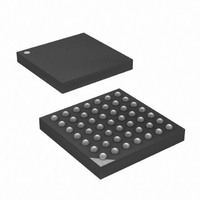ATXMEGA32A4-CUR Atmel, ATXMEGA32A4-CUR Datasheet - Page 355

ATXMEGA32A4-CUR
Manufacturer Part Number
ATXMEGA32A4-CUR
Description
MCU AVR 32+4 FLASH 49VFBGA
Manufacturer
Atmel
Series
AVR® XMEGAr
Specifications of ATXMEGA32A4-CUR
Core Processor
AVR
Core Size
8/16-Bit
Speed
32MHz
Connectivity
I²C, IrDA, SPI, UART/USART
Peripherals
Brown-out Detect/Reset, DMA, POR, PWM, WDT
Number Of I /o
34
Program Memory Size
32KB (16K x 16)
Program Memory Type
FLASH
Eeprom Size
2K x 8
Ram Size
4K x 8
Voltage - Supply (vcc/vdd)
1.6 V ~ 3.6 V
Data Converters
A/D 12x12b, D/A 2x12b
Oscillator Type
Internal
Operating Temperature
-40°C ~ 85°C
Package / Case
49-VFBGA
For Use With
ATAVRONEKIT - KIT AVR/AVR32 DEBUGGER/PROGRMMRATSTK600 - DEV KIT FOR AVR/AVR32770-1007 - ISP 4PORT ATMEL AVR MCU SPI/JTAG770-1004 - ISP 4PORT FOR ATMEL AVR MCU SPI
Lead Free Status / RoHS Status
Lead free / RoHS Compliant
Available stocks
Company
Part Number
Manufacturer
Quantity
Price
- Current page: 355 of 445
- Download datasheet (6Mb)
29.5.6.2
29.5.6.3
29.5.6.4
29.5.6.5
29.5.6.6
8077H–AVR–12/09
STS - Store data to PDIBUS Data Space using direct addressing
LD - Load data from PDIBUS Data Space using indirect addressing
ST - Store data to PDIBUS Data Space using indirect addressing
LDCS - Load data from PDI Control and Status Register Space
STCS - Store data to PDI Control and Status Register Space
address/data sizes are supported; byte, word, 3 bytes, and long (4 bytes). It should be noted that
multiple-bytes access is internally broken down to repeated single-byte accesses. The main
advantage with the multiple-bytes access is that it gives a way to reduce the protocol overhead.
When using the LDS, the address byte(s) must be transmitted before the data transfer.
The ST instruction is used to store data that is serially shifted into the physical layer shift-register
to locations within the PDIBUS Data Space. The STS instruction is based on direct addressing,
which means that the address must be given as an argument to the instruction. Even though the
protocol is based on byte-wise communication, the ST instruction supports multiple-bytes
address - and data access. Four different address/data sizes are supported; byte, word, 3 bytes,
and long (4 bytes). It should be noted that multiple-bytes access is internally broken down to
repeated single-byte accesses. The main advantage with the multiple-bytes access is that it
gives a way to reduce the protocol overhead. When using the STS, the address byte(s) must be
transmitted before the data transfer.
The LD instruction is used to load data from the PDIBUS Data Space to the physical layer shift-
register for serial read-out. The LD instruction is based on indirect addressing (pointer access),
which means that the address must be stored into the Pointer register prior to the data access.
Indirect addressing can be combined with pointer increment. In addition to read data from the
PDIBUS Data Space, the Pointer register can be read by the LD instruction. Even though the
protocol is based on byte-wise communication, the LD instruction supports multiple-bytes
address - and data access. Four different address/data sizes are supported; byte, word, 3 bytes,
and long (4 bytes). It should be noted that multiple-bytes access is internally broken down to
repeated single-byte accesses. The main advantage with the multiple-bytes access is that it
gives a way to reduce the protocol overhead.
The ST instruction is used to store data that is serially shifted into the physical layer shift-register
to locations within the PDIBUS Data Space. The ST instruction is based on indirect addressing
(pointer access), which means that the address must be stored into the Pointer register prior to
the data access. Indirect addressing can be combined with pointer increment. In addition to write
data to the PDIBUS Data Space, the Pointer register can be written by the ST instruction. Even
though the protocol is based on byte-wise communication, the ST instruction supports multiple-
bytes address - and data access. Four different address/data sizes are supported; byte, word, 3
bytes, and long (4 bytes). It should be noted that multiple-bytes access is internally broken down
to repeated single-byte accesses. The main advantage with the multiple-bytes access is that it
gives a way to reduce the protocol overhead.
The LDCS instruction is used to load data from the PDI Control and Status Registers to the
physical layer shift-register for serial read-out. The LDCS instruction supports only direct
addressing and single-byte access.
The STCS instruction is used to store data that is serially shifted into the physical layer shift-reg-
ister to locations within the PDI Control and Status Registers. The STCS instruction supports
only direct addressing and single-byte access.
XMEGA A
355
Related parts for ATXMEGA32A4-CUR
Image
Part Number
Description
Manufacturer
Datasheet
Request
R

Part Number:
Description:
DEV KIT FOR AVR/AVR32
Manufacturer:
Atmel
Datasheet:

Part Number:
Description:
INTERVAL AND WIPE/WASH WIPER CONTROL IC WITH DELAY
Manufacturer:
ATMEL Corporation
Datasheet:

Part Number:
Description:
Low-Voltage Voice-Switched IC for Hands-Free Operation
Manufacturer:
ATMEL Corporation
Datasheet:

Part Number:
Description:
MONOLITHIC INTEGRATED FEATUREPHONE CIRCUIT
Manufacturer:
ATMEL Corporation
Datasheet:

Part Number:
Description:
AM-FM Receiver IC U4255BM-M
Manufacturer:
ATMEL Corporation
Datasheet:

Part Number:
Description:
Monolithic Integrated Feature Phone Circuit
Manufacturer:
ATMEL Corporation
Datasheet:

Part Number:
Description:
Multistandard Video-IF and Quasi Parallel Sound Processing
Manufacturer:
ATMEL Corporation
Datasheet:

Part Number:
Description:
High-performance EE PLD
Manufacturer:
ATMEL Corporation
Datasheet:

Part Number:
Description:
8-bit Flash Microcontroller
Manufacturer:
ATMEL Corporation
Datasheet:

Part Number:
Description:
2-Wire Serial EEPROM
Manufacturer:
ATMEL Corporation
Datasheet:











